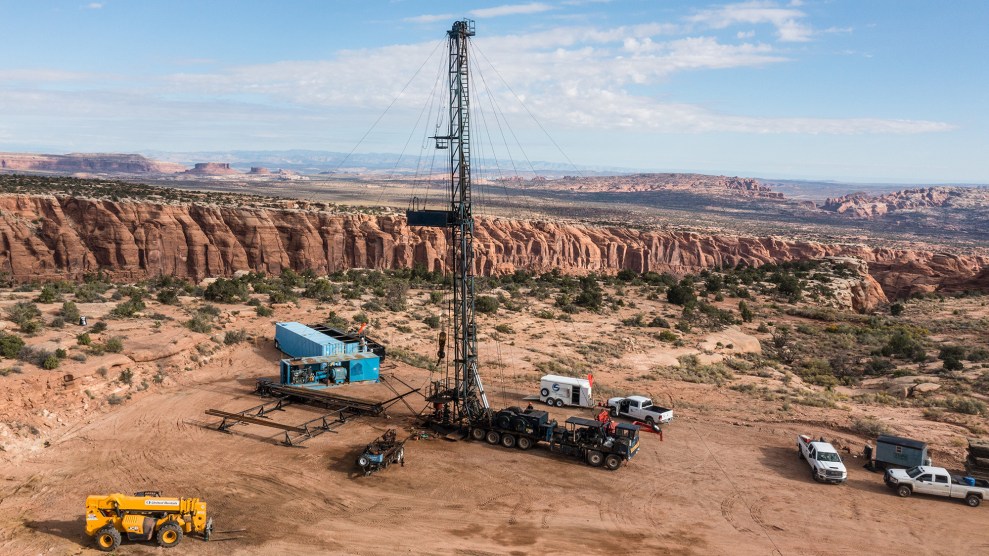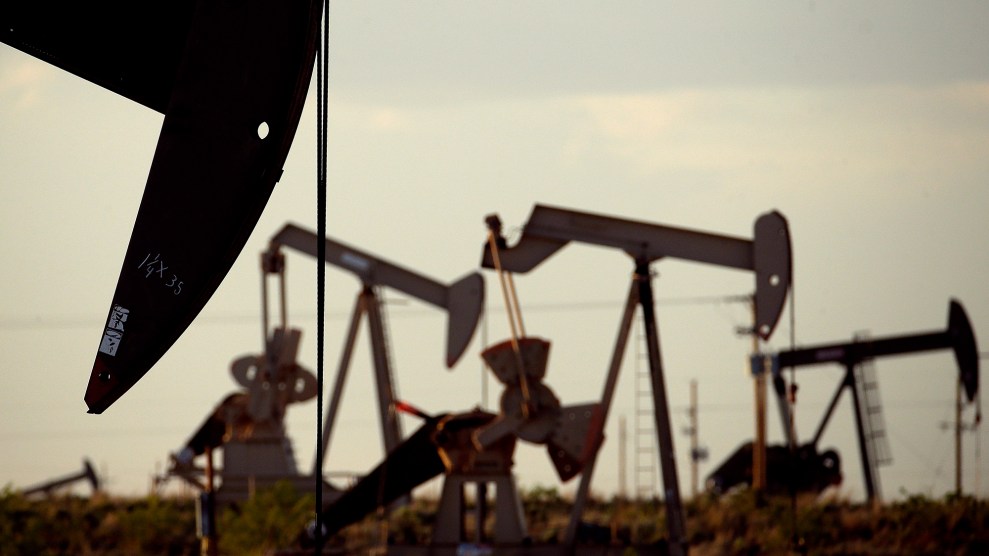
Destruction of a home and vehicle in the aftermath of Hurricane Ian last October in Florida, a state where private equity is swooping in for the big bucks. Jocelyn Augustino/Fema/Planet Pix/Zuma
This story was originally published by the Guardian and is reproduced here as part of the Climate Desk collaboration.
Private equity firms are increasingly profiting from cleaning up climate disasters in the US, while failing to better protect workers and often also investing in the fossil fuels that are causing the climate emergency, new research has found.
The demand for skilled disaster restoration or resilience workers, who are mostly immigrants and refugees from Latin America and Asia, is soaring as greenhouse gases released by burning fossil fuels heat the planet, provoking more destructive storms, floods and wildfires.
As the industry has become more profitable, at least 72 companies that specialize in disaster cleanups and restoration have been acquired by private equity firms since 2020, according to the research, by the Private Equity Stakeholder Project and Resilience Force, a labor rights organization with thousands of members.
Wage theft, lack of protective clothing, and other unsafe conditions are rampant across the industry at the expense of workers, communities and climate, according to the report, Private Equity Profits from Disasters, shared exclusively with the Guardian.
At risk are tens of thousands of resilience workers, traveling from disaster to disaster cleaning up and rebuilding American communities while facing hazards such as unstable buildings, ash and other toxins, and water-borne diseases.
Researchers found that an increasingly complex web of franchises, contractors and subcontractors, insurance providers, labor brokers and agencies and mostly temporary jobs makes it difficult for workers to know who is ultimately accountable for violations.
“Disasters have become more intense and destructive, and rebuilding has become more profitable. As the money started pouring in, companies started consolidating, and private equity started circling and buying up these companies,” said Saket Soni, director of Resilience Force. “Wage theft and health and safety violations are deeply endemic … and private equity is failing to establish higher standards.”
Osha, the federal Occupational Safety and Health Administration, recorded 194 violations at private-equity owned restoration companies and their franchises between January 2015 and January 2022, the report found. Most violations were classified as serious, and included failures to protect workers from asbestos, respiratory problems and falls. (The true number of health and safety violations is likely to be higher, given the small number of OSHA compliance officers).
It is impossible to say precisely what proportion of the disaster workforce is currently controlled by private equity, but acquisitions are gathering pace, with 14 in the first six months of this year compared to 13 during the entire course of 2020. Acquisitions included companies from 28 states, but most were in Florida and Texas—states hit by multiple billion-dollar climate disasters in recent years.
“This is the latest example of a disturbing trend where we see private equity coming into industries where there is a lot of money—and indeed a lot of federal investment—in order to pad their pockets by cutting costs,” said the Democratic congresswoman Pramila Jayapal. “This is already a dangerous industry…cutting costs will cut quality, and increase the threats to essential workers—who are already extremely vulnerable to greedy employers. Those who put up the money, in this case private equity, are ultimately responsible.”
Overall, the number and cost of weather and climate disasters in the US is rising due to a combination of population growth, development and the influence of human-caused global heating on extreme events like floods, drought and fires. Over the past seven years (2016 to 2022), 122 separate billion-dollar disasters have killed at least 5,000 people and cost more than $1 trillion in damage, according to data compiled by the National Oceanic and Atmospheric Administration.
Historically, the disaster restoration industry was made up of smaller, independent businesses handling local projects. But after Hurricane Katrina in 2005, private equity firms saw an opportunity to consolidate the market by buying up smaller companies, and some estimates value the US restoration industry as high as $200 billion. The Restoration Industry Association, whose board includes three private equity executives, did not respond to the Guardian.
Taxpayer dollars increasingly pay for restoration costs—involving public buildings like schools and hospitals, and for folks without insurance. Yet the Federal Emergency Management Agency, FEMA, does not attach mandatory labor or health and safety standards to its payouts, while private equity firms have a track record in cost-cutting to maximize profits.
Private equity refers to an opaque form of private financing in which funds and investors buy and restructure companies, including troubled businesses and real estate, using money from wealthy individuals and institutional investors such as university endowments and state employee pension funds.
In recent years, some private equity firms have become major greenhouse gas polluters, often acquiring risky oil, gas and coal projects with minimal public scrutiny or regulatory oversight—which means firefighters, nurses and teachers have little way of knowing if their retirement nest egg is financing police surveillance equipment, disaster companies or leaky pipelines.
Researchers found a third of the private equity companies with disaster restoration company investments are also backing fossil fuel-linked projects—ostensibly profiting from the cause and effect of the climate emergency.
The Blackstone Group, the world’s largest private equity firm, which manages over $1 trillion, backs 21 energy companies, of which 52 percent are fossil-fuel projects. In 2020, Blackstone’s power plants produced 18.1 million metric tons of carbon dioxide emissions into the atmosphere—equivalent to the annual emissions of nearly 4 million gas-powered vehicles.
Blackstone’s institutional investors include Los Angeles, Maine, Arizona, North Carolina, Texas, New York state, and Oregon public sector worker pensions.
In March 2019, Blackstone acquired a majority share in Servpro Industries, a damage restoration company with more than 2,000 independently owned and operated franchises across the US and Canada. Servpro franchises helped with restoration efforts after Hurricanes Harvey, Matthew and Sandy—some of the most devastating storms to hit the US mainland in recent years. Higher temperatures and sea level rise caused by burning fossil fuels are making storms more intense and destructive.
In Massachusetts, a Servpro franchise in 2022 settled claims by the state that its restoration work at an elementary school led to asbestos contamination, forcing the school to close for months. In November 2019, a Servpro franchise in Boynton Beach, Florida, was forced to pay more $200,000 in back wages to almost 150 restoration workers after a department of labor investigation.
In another example the commercial restoration firm BlueSky, which operates in more than 40 states, is owned by two private equity companies including Partners Group, whose portfolio also includes gas pipeline companies in the US and Europe.
“Firms like Blackstone are using the public’s money to personally profit off both sides of disasters,” said Azani Creeks, PESP research coordinator and co-author of the report.
“Public employees have a right to know that their pension dollars are being used to purchase fossil-fuel plants that are contributing to climate disasters—and companies that profit off of these very disasters, most often off the backs of wage workers with little health and safety protections.”
A Blackstone spokesperson rejected the report’s findings as “cherry-picking,” and said that some of the cases related to matters prior to their investment—and that there was no evidence that the alleged shortcomings were related to private equity ownership:
“As a franchisor, Servpro Industries does not control or direct the operations of its independent local franchises, nor does it employ their workers…Since Blackstone’s investment, the company has expanded the training resources available to its franchisees—including worker safety related to Osha compliance and use of personal protective equipment, among other areas—and continually evaluates ways to further expand and enhance those efforts.”
Blackstone had invested more than $20 billion in the energy transition, the spokesperson said: “Legacy exploration and production investments today total less than 1 percent of our overall fair market value portfolio.”
According to the 2022 state of the industry report, the biggest issues facing the disaster restoration industry is finding—and retaining—skilled workers, and increasing wages for certified employees.
Information about the disaster workforce is limited, but more than 100,000 people are estimated to work occasionally or full time in the industry, according to Resilience Force. Most workers are concentrated in southern states prone to natural disasters like Louisiana, Texas and Florida, but are often deployed thousands of miles away for weeks or months at a time. It is a male-dominated industry, but also includes thousands of women, with Honduras, El Salvador, Mexico, Venezuela, Brazil, India, and the Philippines among some of the most common countries of origin.
While the work is predominantly done by immigrants who are often undocumented or have temporary residency status, the workforce also includes current and ex-incarcerated people and US-born people of color—also groups which have historically faced discrimination and poor working conditions.
In one case, migrant workers who helped rebuild luxury hotels destroyed by Hurricane Irma in Florida Keys in 2017, were forced to sue Cotton Commercial, acquired by the private equity firm Sun Capital in 2020, and a temp agency to recover more than $280,000 in back pay and damages.
A spokesperson for Cotton said: “All Cotton contracts include provisions on subcontractors’ responsibility for payment to their personnel in accordance with all applicable employment laws and regulations, as well as strict safety requirements.”
The need for climate resilience workers is likely to continue rising, and next month Jayapal will re-introduce the 2022 Climate Resilience Workforce Act which would help create a well-trained, fairly paid workforce to help the US prepare for the climate emergency—and ease the transition to a green economy.
Soni, the director of Resilience Force, said: “Disaster restoration is a public good, and we need a strong sustainable workforce as disasters increase. Many people deeply love the work and are dedicated…but the work gets more dangerous year after year, because there are no standards. We’re depleting the workforce when we ought to be building it.”












